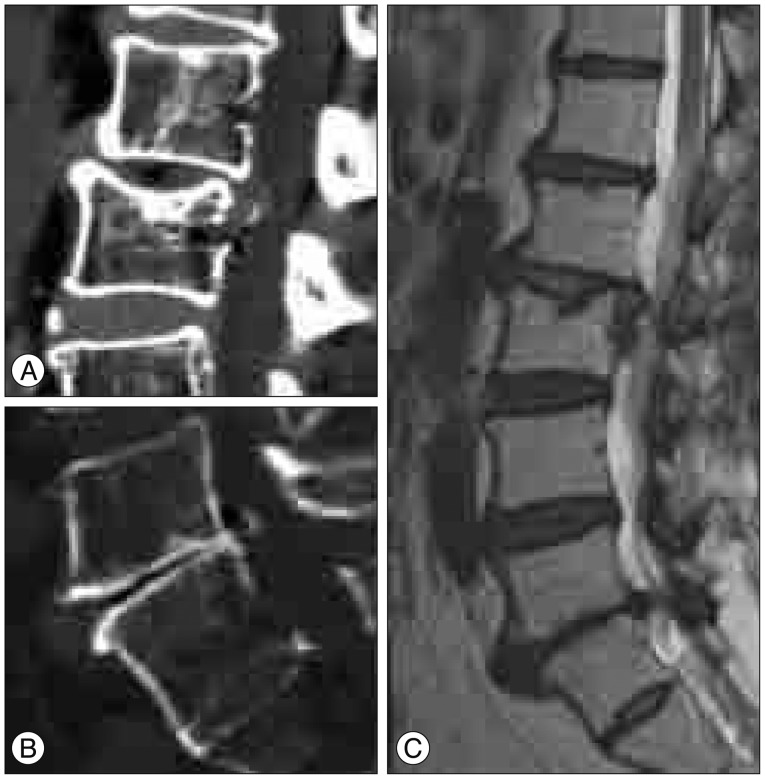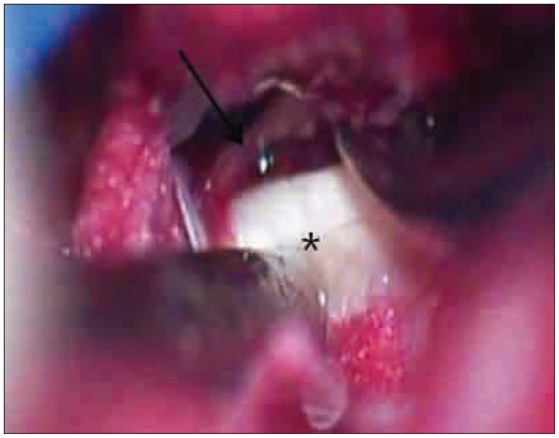J Korean Neurosurg Soc.
2014 Dec;56(6):521-526. 10.3340/jkns.2014.56.6.521.
Radicular Compression by Intraspinal Epidural Gas Bubble Occurred in Distant Two Levels after Lumbar Microdiscectomy
- Affiliations
-
- 1Department of Neurosurgery, St. Peter's Hospital, Seoul, Korea. mannitol240@gmail.com
- KMID: 2191151
- DOI: http://doi.org/10.3340/jkns.2014.56.6.521
Abstract
- The authors report a case of symptomatic epidural gas accumulation 2 weeks after the multi-level lumbar surgery, causing postoperative recurrent radiculopathy. The accumulation of epidural gas compressing the dural sac and nerve root was demonstrated by CT and MRI at the distant two levels, L3-4 and L5-S1, where vacuum in disc space was observed preoperatively and both laminectomy and discectomy had been done. However, postoperative air was not identified at L4-5 level where only laminectomy had been done in same surgical field, which suggested the relationship between postoperative epidural gas and the manipulation of disc structure. Conservative treatment and needle aspiration was performed, but not effective to relieve patient's symptoms. The patient underwent revision surgery to remove the gaseous cyst. Her leg pain was improved after the second operation.
Figure
Reference
-
1. Bosser V, Dietemann JL, Warter JM, Granel de Solignac M, Beaujeux R, Buchheit F. L5 radicular pain related to lumbar extradural gas-containing pseudocyst. Role of CT-guided aspiration. Neuroradiology. 1990; 31:552–553. PMID: 2352640.
Article2. Capelle HH, Krauss JK. Recurrent sciatica due to periligamentous trapped epidural gas after spinal sequestrectomy. J Neurosurg Spine. 2006; 4:75–77. PMID: 16506470.
Article3. Charles RW, Mody GM, Govender S. Pyogenic infection of the lumbar vertebral spine due to gas-forming organisms. A case report. Spine (Phila Pa 1976). 1989; 14:541–543. PMID: 2727800.
Article4. Cheng TM, Link MJ, Onofrio BM. Pneumatic nerve root compression : epidural gas in association with lateral disc herniation. Report of two cases. J Neurosurg. 1994; 81:453–458. PMID: 8057154.
Article5. Ford LT, Gilula LA, Murphy WA, Gado M. Analysis of gas in vacuum lumbar disc. AJR Am J Roentgenol. 1977; 128:1056–1057. PMID: 414544.
Article6. Gulati AN, Weinstein ZR. Gas in the spinal canal in association with the lumbosacral vacuum phenomenon : CT findings. Neuroradiology. 1980; 20:191–192. PMID: 7465037.
Article7. Hidalgo-Ovejero AM, García-Mata S, Gozzi-Vallejo S, Izco-Cabezón T, Martínez-Morentín J, Martínez-Grande M. Intradural disc herniation and epidural gas : something more than a casual association? Spine (Phila Pa 1976). 2004; 29:E463–E467. PMID: 15480124.8. Ilica AT, Kocaoglu M, Bulakbasi N, Kahraman S. Symptomatic epidural gas after open discectomy : CT and MR imaging findings. AJNR Am J Neuroradiol. 2006; 27:998–999. PMID: 16687531.9. Kakitsubata Y, Theodorou SJ, Theodorou DJ, Yuko M, Ito Y, Yuki Y, et al. Symptomatic epidural gas cyst associated with discal vacuum phenomenon. Spine (Phila Pa 1976). 2009; 34:E784–E789. PMID: 19934800.
Article10. Kaymaz M, Oztanir N, Emmez H, Ozköse Z, Paşaoğlu A. Epidural air entrapment after spinal surgery. Clin Neurol Neurosurg. 2005; 107:421–424. PMID: 16023539.
Article11. Malghem J, Maldague B, Labaisse MA, Dooms G, Duprez T, Devogelaer JP, et al. Intravertebral vacuum cleft : changes in content after supine positioning. Radiology. 1993; 187:483–487. PMID: 8475295.
Article12. Mortensen WW, Thorne RP, Donaldson WF 3rd. Symptomatic gas-containing disc herniation. Report of four cases. Spine (Phila Pa 1976). 1991; 16:190–192. PMID: 2011775.
Article13. Pak KI, Hoffman DC, Herzog RJ, Lutz GE. Percutaneous intradiscal aspiration of a lumbar vacuum disc herniation : a case report. HSS J. 2011; 7:89–93. PMID: 22294964.
Article14. Raynor RB, Saint-Louis L. Postoperative gas bubble foot drop. A case report. Spine. 1999; 24:299–301. PMID: 10025027.15. Ricca GF, Robertson JT, Hines RS. Nerve root compression by herniated intradiscal gas. Case report. J Neurosurg. 1990; 72:282–284. PMID: 2295923.16. Righini A, Lucchi S, Reganati P, Zavanone M, Bettinelli A. Percutaneous treatment of gas-containing lumbar disc herniation. Report of two cases. J Neurosurg. 1999; 91(1 Suppl):133–136. PMID: 10419361.17. Sasani M, Ozer AF, Oktenoglu T, Cosar M, Karaarslan E, Sarioglu AC. Recurrent radiculopathy caused by epidural gas after spinal surgery : report of four cases and literature review. Spine (Phila Pa 1976). 2007; 32:E320–E325. PMID: 17471081.18. Tsitouridis I, Sayegh FE, Papapostolou P, Chondromatidou S, Goutsaridou F, Emmanouilidou M, et al. Disc-like herniation in association with gas collection in the spinal canal : CT evaluation. Eur J Radiol. 2005; 56:1–4. PMID: 16168257.
Article19. Wang HJ, Chen BB, Yu CW, Hsu CY, Shih TT. Alteration of disc vacuum contents during prolonged supine positioning : evaluation with MR image. Spine (Phila Pa 1976). 2007; 32:2610–2615. PMID: 17978662.20. Yoshida H, Shinomiya K, Nakai O, Kurosa Y, Yamaura I. Lumbar nerve root compression caused by lumbar intraspinal gas. Report of three cases. Spine (Phila Pa 1976). 1997; 22:348–351. PMID: 9051898.
- Full Text Links
- Actions
-
Cited
- CITED
-
- Close
- Share
- Similar articles
-
- A Case of Intraspinal Gas-containing Cyst associated with Severe Lumbar Spondylosis
- Symptomatic Epidural Gas-containing Cyst from Intervertebral Vacuum Phenomenon
- Postlaminectomy Bilateral Lumbar Intraspinal Synovial Cysts
- Transient Asymptomatic Intraspinal Cyst-like Lesion with Epidural Nerve Block
- L2 Radicular Compression Caused by a Foraminal Extradural Gas Pseudocyst





